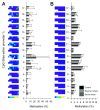Epigenetic regulation of the glucocorticoid receptor promoter 1(7) in adult rats
- PMID: 23023726
- PMCID: PMC3499330
- DOI: 10.4161/epi.22363
Epigenetic regulation of the glucocorticoid receptor promoter 1(7) in adult rats
Abstract
Regulation of glucocorticoid receptor (GR) levels is an important stress adaptation mechanism. Transcription factor Nfgi-a and environmentally induced Gr promoter 1 7 methylation have been implicated in fine-tuning the expression of Gr 1 7 transcripts. Here, we investigated Gr promoter 1 7 methylation and Gr 1 7 expression in adult rats exposed to either acute or chronic stress paradigms. A strong negative correlation was observed between the sum of promoter-wide methylation levels and Gr 1 7 transcript levels, independent of the stressor. Methylation of individual sites did not, however, correlate with transcript levels. This suggested that promoter 1 7 was directly regulated by promoter-wide DNA methylation. Although acute stress increased Ngfi-a expression in the hypothalamic paraventricular nucleus (PVN), Gr 1 7 transcript levels remained unaffected despite low methylation levels. Acute stress had little effect on these low methylation levels, except at four hippocampal CpGs. Chronic stress altered the corticosterone response to an acute stressor. In the adrenal and pituitary glands, but not in the brain, this was accompanied by an increase in methylation levels in orchestrated clusters rather than individual CpGs. PVN methylation levels, unaffected by acute or chronic stress, were significantly more variable within- than between-groups, suggesting that they were instated probably during the perinatal period and represent a pre-established trait. Thus, in addition to the known perinatal programming, the Gr 1 7 promoter is epigenetically regulated by chronic stress in adulthood, and retains promoter-wide tissue-specific plasticity. Differences in methylation susceptibility between the PVN in the perinatal period and the peripheral HPA axis tissues in adulthood may represent an important "trait" vs. "state" regulation of the Gr gene.
Figures







References
Publication types
MeSH terms
Substances
LinkOut - more resources
Full Text Sources
